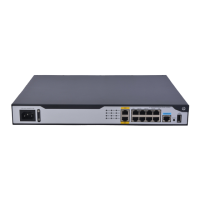418
IP address: 192.168.0.2, port number: 5001, host facility: local5
Log buffer: Enabled
Max buffer size 1024, current buffer size 512,
Current messages 0, dropped messages 0, overwritten messages 0
Log file: Enabled
Security log file: Enabled
Information timestamp format:
Loghost: Date
Other output destination: Date
display logbuffer
Use display logbuffer to display the state of the log buffer and the log information in the log buffer.
Syntax
Centralized devices in standalone mode:
display logbuffer [ reverse ] [ level severity | size buffersize ] *
Distributed devices in standalone mode/centralized devices in IRF mode:
display logbuffer [ reverse ] [ level severity | size buffersize | slot slot-number ] *
Distributed devices in IRF mode:
display logbuffer [ reverse ] [ level severity | size buffersize | chassis chassis-number slot slot-number ]
*
Views
Any view
Predefined user roles
network-admin
network-operator
Parameters
reverse: Displays log entries chronologically, with the most recent entry at the top. If you do not specify
this keyword, the command displays log entries chronologically, with the oldest entry at the top.
level severity: Specifies a severity level in the range of 0 to 7. If you do not specify a severity level, this
command displays log information for all levels.
Table 87 Log levels
Severity
value
Level Description
Corresponding
keyword in
commands
0 Emergency
The system is unusable. For example, the system
authorization has expired.
emergency
1 Alert
Action must be taken immediately. For example, traffic on
an interface exceeds the upper limit.
alert
2 Critical
Critical condition. For example, the device temperature
exceeds the upper limit, the power module fails, or the fan
tray fails.
critical

